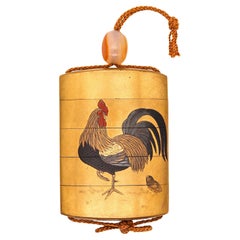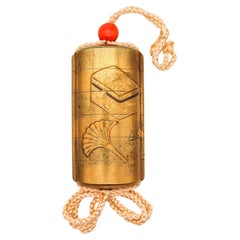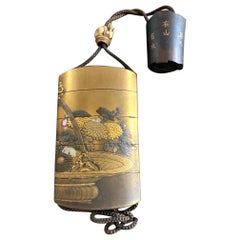Cord Lacquer
2
to
2
2
2
2
2
2
3,333
466
280
113
43
2
2
2
Material: Cord
Japan 1810 Kajikawa Edo Period Five Drawer Inro Lacquered Gilt Wood With Rooster
Located in Miami, FL
Japanese Inro from the Edo period (1615-1868) created by Kajikawa.
Beautiful Inro, created in Japan by one of the Kajikawa family during the Edo period (1615-1868), circa 1810. Has been carefully crafted in carved precious wood with applications of gilding maki-e and decorated with Japonism patterns. All dan trays are attached together with a himo cord. The detailed craftsmanship was a true pleasure to behold.
Period: Edo period (1615-1868). Shogunate.
Approximate Date: 1790-1810
Motif: A family of birds consisting of a cockerel, the hen and three chicks.
Drawers: Five.
Shape: Rectangular navette.
Technique: Carved wood, lacquer and decorated in iroe-hiramaki-e on a gold ground.
Ojime: 15mm 20mm, oval carved from natural translucent agate.
Netsuke: None
Weight: 47.70 Grams.
Measurements: Inro is 78 mm by 55 mm by 18 mm (3.07 x 2.17 x 0.71 Inches).
Signatures: Kajikawa Saku, in the underside with the signature KAJIKAWA. By a member of the Kajikawa family, signed Kajikawa 梶川 Japan, late 18th century to early 19th century, Edo period (1615-1868).
The Kajikawa family
Kajikawa family, flourished in the 19th century, they was Japanese lacquerware artists whose school in Edo (now Tokyo) flourished for more than 200 years. This family is perhaps the most famous of all the dynasties of Japanese lacquer artists, and certainly the name most often found on inro. The family is said to have been founded by Hikobei at Edo in the early 17th century, although some claim that the family’s great reputation really stemmed from his son and pupil Kyujiro. In any event, Hikobei worked for the shogunate, as did his successors until well into the 19th century. Kijirō excelled in designing particularly delicate lacquer inrō, portable medicine cases...
Category
1810s Japanese Edo Antique Cord Lacquer
Materials
Agate, Gold
Japan 1800 Edo Period Six Drawer Inro In Lacquered Gilt Wood With Utensils
Located in Miami, FL
Japanese Inro from the Edo Period (1603-1867).
Beautiful Inro, created in Japan during the Edo period (Shogunate), circa 1800. It was carefully crafted in carved precious wood with ...
Category
Early 1800s Japanese Edo Antique Cord Lacquer
Materials
Coral
Related Items
Antique Japanese Inro by Shigehide Edo Period
Located in Atlanta, GA
This exquisite four-case lacquered inro was dated to the latter part of 18th century to early 19th century (Edo period) and made by Shigehide. The opposite sides of the inro together features a lavish flower arrangement in a bamboo basket (ikebana). The detailed craftmanship was a true pleasure to behold. Mostly Takamaki-e (high relief) were used to texturize the delicate petals of the chrysanthemums, on which different shades of gold were used to create contrast. Raden (mother of pearl) shells were also used to highlight some leaves, rendering the piece an interesting balance of color and material. The interior was completed in a mottled gold finish. It was signed Shigehide on the bottom with a Kao. There is a small carved rabbit ojime bead...
Category
Late 18th Century Japanese Japonisme Antique Cord Lacquer
Materials
Wood, Lacquer
Japanese Lacquer and Cinnabar "Samurai" Cabinet, Inaba Family, Edo Period
Located in Troy, NY
Exceptionally large and rare lacquer cabinet. According to the heraldry, visible on the headgear in one of the panels, it was made for the Inaba family, a high ranking Daimyo family,...
Category
Late 19th Century Japanese Edo Antique Cord Lacquer
Materials
Wood
A Japanese maki-è lacquer inro
Located in Milano, IT
Japanese inro with two compartments, in maki-è lacquer with nashiji decorations and circular reserves depicting flowers and leaves.
Coral colored ojime and lacquer manju netsuke. Si...
Category
Mid-19th Century Japanese Japonisme Antique Cord Lacquer
Materials
Lacquer
Japanese Maki-e Lacquer Document Box, Edo Period, early 19th Century, Japan
Located in Austin, TX
A spectacular Japanese maki-e lacquer lidded box, possibly a writing box, suzuribako, decorated with images of folding fans, ogi, Edo Period, earl...
Category
Early 19th Century Japanese Edo Antique Cord Lacquer
Materials
Coral
Japanese Lacquer Box, Kobako, "The Ivy Way", Edo Period, 19th Century, Japan
Located in Austin, TX
An exquisite Japanese tall lacquer box for incense implements, kobako, with a scene from The Tales of Ise, chapter 9, "The Ivy Way Through Mt. Utsu", Edo ...
Category
Mid-19th Century Japanese Edo Antique Cord Lacquer
Materials
Lacquer
Japanese Lacquer Incense Burner, Koro, Edo period, mid 19th century, Japan
Located in Austin, TX
An elegant and refined Japanese lacquer koro, incense burner, in the form of a chaire, tea caddy, Edo Perio, mid 19th century, Japan.
The barrel shaped koro formed as a traditional ...
Category
Mid-19th Century Japanese Edo Antique Cord Lacquer
Materials
Copper
Japanese Lacquer Stationery Box, Suzuribako, Edo Period, 19th c, Japan
Located in Austin, TX
A fine and elegant Japanese lacquer box for writing implements or stationery, suzuribako, with an image of a Shinto shrine, Edo Period, mid-19th century, circa 1840, Japan.
The exqu...
Category
Mid-19th Century Japanese Edo Antique Cord Lacquer
Materials
Gold Leaf
Free Shipping
H 1.75 in W 6.25 in D 9 in
Japanese Lacquer Smoking Box, Tabako Bon, Edo Period, 19th Century
Located in Austin, TX
A very fine Japanese maki-e lacquer decorated tabako bon, or smoking box, late Edo Period, mid-19th century, Japan.
The elegant smoking box of black lacquer decorated with a wonderful gold lacquer takamaki-e design of a gnarled and elegantly twisted plum tree with branches in full bloom. A border of golden cranes in flight to the top.
The smoking box, called a tabako bon, is comprised of an open section at the top with inset with two cylindrical metal canisters...
Category
Mid-19th Century Japanese Edo Antique Cord Lacquer
Materials
Lacquer
Five-Case Inrō 19th Century Signed Kajikawa Saku Japanese Lacquer Box
Located in Milano, IT
Signed: “Kajikawa saku” and with a red pot seal
Height: 3 1/8in (7.9cm)
Provenance:
Michael Tomkinson Collection
Leonard Haber Collection
Literature:
Michael Tomkinson, A Japanese Collection, London: George Allen, 1898, no. 300
Each case with slightly recessed joints and with different grounds, including kinji, nashiji, togidashi maki-e and gyobu-nashiji, on the obverse decorated with a treasure ship laden with the attributes of the Seven Gods...
Category
19th Century Japanese Antique Cord Lacquer
Materials
Wood, Lacquer
Rare Japanese Sumi-E Lacquer Inro Yamada Jokasai Edo Period
Located in Atlanta, GA
A three-case lacquered Inro by Yamada Family circa 18th-19th century Edo period. The inro with slight rounded form is of Kano style and vividly depicts a dragon slithering among the ink clouds on a gold background. Sumi-e togidashi (ink togidashi) technique, in combination with Hiramaki-e, were employed to create the dreamy ambience of this piece. The dragon has a painterly appearance inspired by Chinese ink painting that was often seen on the Japanese folding screens. The back of the Inro was sparsely decorated with the shifting patterns of the darkening clouds with an emphasis on the space intentionally left empty. Jokasai was signed to the base. On the front of the inro there is another miniature signature Hakugyoku Hogen, which is one of names used by Kano Michinobu (1730-1790). The dragon is evidently one of his designs (see reference below).
Established by a member of Yamada family in the 17th century, the clan was one of the most prominent lacquer artisanal family for the next 200 years until the end of Edo period in the 19th century. Most members signed their work simply with Jokasai making the identification of the individual artists somewhat impossible. The current Inro on offer, compared to many other pieces by Jokasai, has an uncommon Kano style done in Sumi-e togidashi.
Another unusual feature of this piece is that the interiors of the inro was decorated with an interesting gold mosaic inlays (kirigane) on a dark lacquer background, giving it a jewel like quality.
For another Inro by Jokasai of a similar style using Sumi-e togidashi but depicts a tiger, see Wrangham collection, no.353, which was offered for sale as lot 256 in Bonham's London Auction: The Edward Wrangham Collection of Japanese Art Part I. 9 Nov 2010.
For an ink scroll...
Category
18th Century Japanese Japonisme Antique Cord Lacquer
Materials
Wood, Lacquer
Japanese Meiji Period Lacquer Six Drawer Inro
Located in Newark, England
The Inro is decorated with a gold lacquer base and features mother of pearl shell inlay leaves surounding wheeled cart with foliage. The Inro with a slide action opening which hides ...
Category
Late 19th Century Japanese Meiji Antique Cord Lacquer
Materials
Rope, Lacquer
Japanese Lacquered Samurai Jingasa Hat Edo Period
Located in Atlanta, GA
A bespoken Japanese historical hat known as Jinggasa (militant hat) that was worn by samurai in Edo period (1603-1868) circa 18-19th century. There were several subtypes of Jingasa a...
Category
19th Century Japanese Japonisme Antique Cord Lacquer
Materials
Wood, Lacquer
Recently Viewed
View AllMore Ways To Browse
Edo Inro
Japanese Ojime
Lac Burgaute
Vintage Japanese Bento Box
Antique Quran Stand
Bone Inro
Burmese Lacquerware Betel Box
Chinese Chippendale Jewelry Box
Chinese Lac Burgaute
Japanese Bone Inro
Kamakura Bori
Manju Netsuke
Nara Chest
Pagan Bya
Temple Ranma Panel
Chinese Enamel Smoking Set
Divider Laque
Japanese Lacquer Inro Bag



